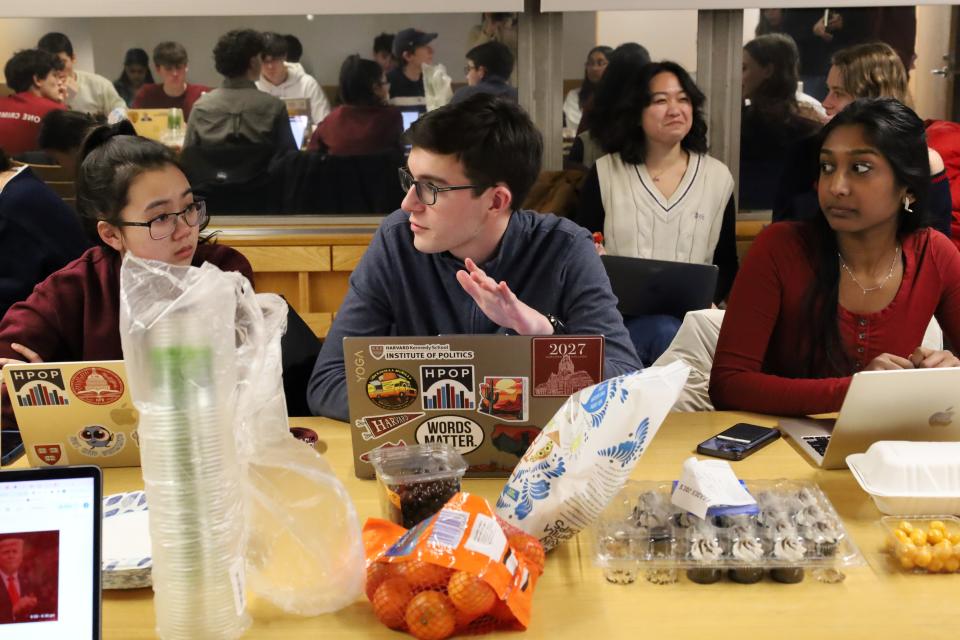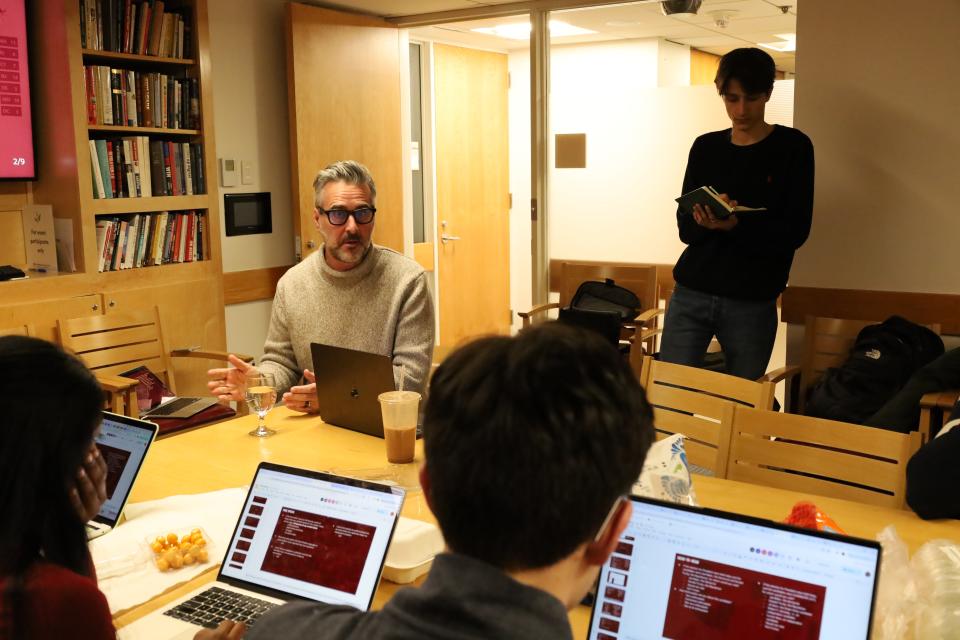The Harvard Public Opinion Project: Meet the Students Running the Annual Youth Poll

Harvard Public Opinion Project
John Della Volpe kicks off new member training for the Harvard Public Opinion Project (HPOP) with a story. “I’m walking out of the White House,” Della Volpe recounts, having just briefed the President’s senior advisors on the latest findings of the bi-annual Harvard Youth Poll, when an aide pulls him aside and into the Oval Office, where the President of the United States is sitting at his desk. President Biden shakes Della Volpe’s hand, thanks him for taking the time to brief his staff, then pauses to ask a question: “Where are the students? Didn’t you say you had students with you?”
As a matter of fact, Della Volpe does. He’s the director of polling at the Harvard Kennedy School’s Institute of Politics dubbed the “Gen Z Whisperer” by pollsters, pundits, and politicians. But in HPOP, students do the talking. For the next half hour, Della Volpe steps back, and HPOP Chairs Alan Zhang and Jing-Jing Shen take the lead. They fill the President in on key findings from the poll. “He spent almost the entire conversation talking to Jing-Jing and I,” says Zhang, now a senior who’s spent eight semesters in HPOP. “His attention was laser-focused on us. He wanted to hear our experiences. He asked what we thought were the biggest issues facing our generation.”
For the last 24 years, HPOP has addressed these exact questions. Every Monday at 6 P.M., our team of 30 student researchers meets at the Harvard Kennedy School of Government to do our namesake work: crafting a nationwide poll that probes our generation on the big issues shaping how we think, live, and vote. We approach the poll by exploring “points of curiosities about our own lives,” says Zhang. “It comes from the conversations that we have, the news that we're seeing, the social media that we're scrolling, and the lives that we live on an everyday basis.” From that launchpoint, we formalize our curiosities into four single-issue research teams, which work to pitch roughly 10 poll questions each. In the latest edition of the poll, we looked at youth disaffection, artificial intelligence and the labor market, and access to reproductive healthcare. This semester, we’re investigating attitudes about masculinity, immigration, and free speech on college campuses.
Nuriel Vera-DeGraff, a sophomore on the foreign policy team, knows that it’s “not a small amount of work” to whittle his team’s big ideas into just 10 questions. “We debate every single word, every single phrase.” It’s true: In weekly meetings, we project the questions onto the wall and spend hours agonizing over why we’re asking the questions that we ask and how to best ask them. We pitch questions, tweak questions, and cut questions only to add them back. Then, on HPOP’s annual Super Monday, we get to business workshopping and finalizing the questions. “It’s fast-paced, it can be chaotic, but it’s always a great time,” says junior Tommy Barone.


From there, HPOP partners with market research firm Ipsos to field the questions to young people online. Once the data arrives, usually within a few weeks, Vera-DeGraff reports that the team starts by “just kind of sifting through everything that's there.” They cross-tab the results of one variable with another, like comparing party identification and gender to views on free expression, and look back at tracking questions to see if trends endure from year to year. “A lot of it is very brute force,” Vera-DeGraff explains, “like checking a lot of different cross-tabs over and over to see what comes up.”
Sophomore Summer Tan agrees: She’s seen people work on questions and poll results until 10 at night, or until security kicks them out of the meeting room. For Tan, and for all of us at HPOP, the poll is a way to see the numbers, but also to make sure that our generation feels like they have a stake in our democracy. All of that comes from being represented as authentically as possible.
It’s why we’ve run questions about Taylor Swift’s impact on get out the vote efforts, and whether or not men are “too soft these days.” It’s why we write questions in a way that resonates with young respondents: We think that no other poll can do what HPOP does. No other pollster understands our generation better than we do — as young people, young voters, and young Americans. So when there’s such energy around unveiling how young people interact with the world around them, no one’s checking the clock during meetings. “We all have an eagerness to really learn,” says Tan.
When it comes to polling, though, Tan adds that it can seem as if researchers place an overly high premium on cold hard numbers, statistics, and percentage points. “HPOP is about taking that and giving it a story,” Tan tells me. “A story that people will understand.” Since the poll is so fundamentally driven by young people, Tan feels a social responsibility to not only report findings to the people inside the world of polling — the academics, journalists, and politicians — but also to those outside of it, whose voices she’s representing, “creating a culture that’s as inclusive of the people who we serve as anyone else.”
We care. A lot. But why should politicians? Jordan Schwartz, who leads the 2024 elections team, puts it point-blank: “Young people are the future.” He says that even if young people aren’t voting today, they’re going to be voting eventually — and even if they choose not to vote eventually, they’re going to feel the impacts of policies longer than members of any other living generation. For Jack Tueting on the liberties research team, who grew up in rural Virginia as a sheep farmer, feeling these impacts and seeing, firsthand, the consequences of issues like climate change on his community, has reinforced the urgency that “we’re going to have to live with the decisions that are being made by our current political leaders.”
“We need to think about what the future holds so that we can envision an America 50 years from now, 100 years from now,” Schwartz continues. “The only way to do that is to get at what young people feel… and polls like ours are part of the thing that gets there.”
But what young people feel might not be so clear. Dominick Lombard, a freshman on the 2024 elections team, tells me that when he tunes into the news, he often hears reporters tell Americans what young people think in “monolithic terms.” But our generation — one that’s over 60 million strong — doesn’t speak with a singular voice. Research team lead Kritika Nagappa was “particularly invested in the culture and gender section” of the latest Spring 2024 Poll. “I really tried to get at what it means to be a young woman or man in America, and how these identities reflect the way we view others and our generation as a whole.” These identities — rural or urban, liberal or conservative, religious or secular — are built into every part of the poll, all the way from the inception of the questions themselves to the briefings of the numbers to the press and to the government. “We do a great job of resonating with our generation,” says Nagappa, and taking young voices into account at every step of the process. “That’s something that only we can achieve because we’re young people ourselves.”
When I ask Zhang for his favorite HPOP memory, he smiles. “We came out of the White House, and as we were taking our first steps outside of the Oval Office, John turned to Jing-Jing and I and goes, ‘HPOP doesn’t f*ck around.’”
HDFA. It’s our motto, email signature, and unofficial mission statement. It sums up our dedication to voicing our generation’s dreams and frustrations, values and visions — so that when our story is being written, it’s us holding the pens.
Correction: Jack Tueting is from Virginia, not West Virginia
Stay up-to-date with the politics team. Sign up for the Teen Vogue Take
Originally Appeared on Teen Vogue
Want more U.S. government coverage?

